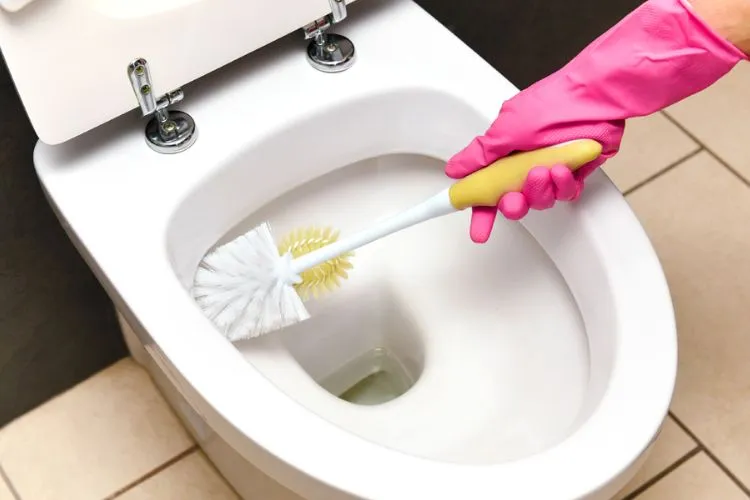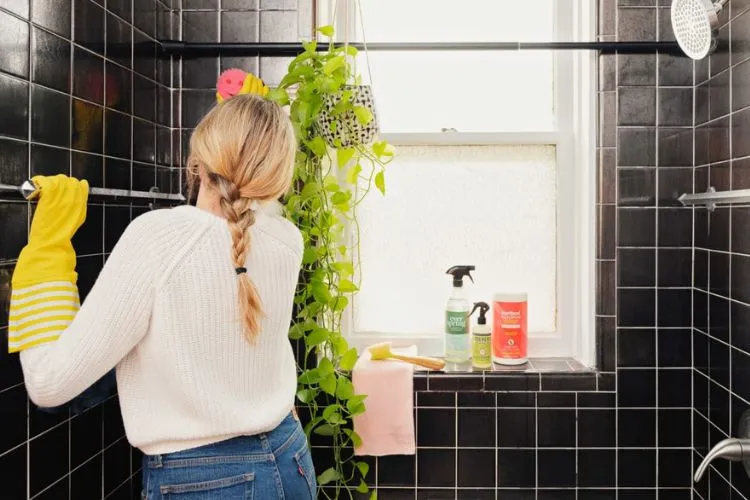Maintaining a pristine and healthy home extends prominently to our bathrooms, with special attention directed towards the toilet bowl.
The prevalence of black mold in toilet bowls presents a widespread concern due to the health risks and unpleasantness it introduces.
But, do you know what causes black mold in toilet bowl?
This comprehensive guide delves into the causes, dangers, and eradication measures for black mold, providing essential knowledge and practical solutions for homeowners.

What Is Black Mold?
Black mold, scientifically known as Stachybotrys chartarum, manifests as dark or black patches and thrives in environments that are moist and warm.
Distinct from other molds due to its potential to cause health issues, black mold’s preference for bathrooms, particularly toilet bowls, necessitates a strategic approach to manage and prevent its proliferation effectively.
What Causes Black Mold In Toilet Bowl?
Persistent Moisture
The inherent moisture within toilet bowls provides a fertile ground for mold spores to settle and multiply. This perpetual dampness, if left unchecked, serves as an ideal environment for the growth of black mold.
Infrequent Cleaning
A lax cleaning regimen can significantly contribute to the development of mold. Routine cleansing is essential in disrupting the lifecycle of mold spores, preventing their establishment and spread.
Leaks and Condensation
Leakages around the toilet base or condensation resulting from temperature variations can elevate moisture levels in the vicinity, thereby bolstering conditions favorable for mold growth.
Poor Ventilation
Limited airflow exacerbates humidity levels, enhancing the bathroom’s appeal to mold spores. Adequate ventilation is thus crucial in curtailing the growth of mold by mitigating moisture accumulation.
The Health Implications of Black Mold

Exposure to black mold poses considerable health risks, particularly affecting individuals with underlying respiratory conditions, compromised immune systems, the elderly, and children.
Symptoms might include respiratory discomfort, allergic reactions, skin irritation, and in severe scenarios, lung infections. Recognizing these pitfalls underscores the necessity for prompt and effective mold management strategies.
Ensuring Regular Cleaning
Adhering to a consistent cleaning schedule, using effective cleaning agents, plays a pivotal role in deterring mold growth. Extra care should be taken to cleanse the toilet bowl and its surroundings thoroughly.
Enhancing Ventilation
Improving air circulation within the bathroom can significantly decrease moisture levels, thereby undermining mold’s ability to thrive. Installation of exhaust fans or the practice of keeping windows open can facilitate this process.
Prompt Leak Addressal
Detecting and repairing leaks in and around the toilet and plumbing fixtures can drastically diminish moisture content, curbing mold proliferation.
Adoption of Anti-Mold Solutions
Incorporating products designed to combat mold, or natural remedies such as vinegar, into cleaning routines can further deter mold growth, creating an environment hostile to spores.
Effective Cleaning and Mold Removal
Do-It-Yourself Cleaning Formulas
Home-based cleaning solutions, comprising white vinegar, baking soda, and water, can prove to be potent against mold. Application of this mixture, followed by thorough scrubbing, can eradicate mild mold infestations.
It is crucial to don protective gear, such as gloves and masks, to safeguard against direct contact with mold and chemical vapors.
Professional Mold Remediation
Should mold infestation persist or extend beyond the toilet bowl, seeking the expertise of professional mold removal services is advisable. These specialists are equipped to safely eliminate mold and offer consultation on preventive practices.
Expert Recommendations for a Mold-Free Bathroom

To sustain a mold-resistant bathroom, employing a squeegee post-shower to remove excess water is recommended. Regular inspections for moisture-related issues should extend beyond the bathroom to ensure comprehensive mold deterrence.
Maintaining a cache of mold-targeted cleaning supplies ensures preparedness to address early signs of mold formation proactively.
Safety Measures When Handling Mold
Protective Gear: When tackling mold removal, it’s crucial to wear the proper safety equipment to protect yourself from harmful spores and chemicals. Essential gear includes N95 masks, which filter out mold spores, along with gloves, goggles, and full-body suits for extensive contamination.
This not only prevents skin contact with mold but also inhalation of spores, which can be especially hazardous to health.
When to Call Professionals: DIY measures are often sufficient for small mold issues, but extensive mold infestation, hidden mold, or mold resulting from sewage or contaminated water requires professional remediation. Professionals have the necessary tools, chemicals, and protective measures to safely and effectively eliminate mold problems that go beyond superficial treatment.
If you experience allergies or any health impact during DIY removal, it’s also a sign to call in the experts to ensure that the job is done safely and thoroughly.
Case Studies and Testimonials
Real-Life Battles: Discover stories from individuals who have combated black mold, sharing strategies like focused cleaning routines and the integration of dehumidifiers to maintain a mold-free environment effectively.
Expert Insights: Gain professional tips on early mold detection and the use of advanced cleaning technologies and products to prevent regrowth, ensuring a safe and clean home.
Frequently Asked Questions (FAQs)
How frequently should toilet bowls be cleaned to avert mold?
Weekly cleaning, alongside routine checks for mold presence, is recommended.
Does black mold in the toilet pose a health threat?
Yes, exposure to black mold can precipitate a variety of health complications, especially for individuals with certain preexisting conditions.
Can black mold in the toilet contaminate drinking water?
No, black mold in the toilet does not directly affect drinking water quality. However, its presence indicates broader moisture control issues.
What indicators suggest black mold in plumbing systems?
Signs include visible dark patches, musty odors, and evidence of water damage near plumbing fixtures.
Are natural solutions effective against black mold?
Yes, substances like white vinegar, tea tree oil, and hydrogen peroxide act as viable natural alternatives for mold mitigation.
Conclusion:
Combatting black mold in toilet bowls is an ongoing endeavor that necessitates understanding its causes, employing effective prevention techniques, and executing timely interventions.
Regular sanitation, optimized ventilation, and immediate response to moisture accumulation are fundamental steps towards maintaining a mold-free bathroom. For instances of stubborn or widespread mold, professional remediation is essential.
By adopting these strategies, homeowners can ensure their bathrooms remain not only cleaner but also healthier for all occupants.


